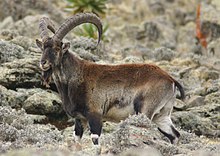This article needs additional citations for verification. (December 2012) |
| Walia ibex | |
|---|---|

| |
| Male | |

| |
| Female with juvenile Semien Mountains National Park, Ethiopia | |
| Scientific classification | |
| Domain: | Eukaryota |
| Kingdom: | Animalia |
| Phylum: | Chordata |
| Class: | Mammalia |
| Order: | Artiodactyla |
| Family: | Bovidae |
| Subfamily: | Caprinae |
| Tribe: | Caprini |
| Genus: | Capra |
| Species: | C. walie
|
| Binomial name | |
| Capra walie Rüppell, 1835
| |

| |
| Range of the walia ibex (in black) | |
The Walia ibex (Capra walie, Amharic: ዋልያ wālyā Oromo: Waliyaa or Gadamsa baddaa) is a vulnerable species of ibex. It is sometimes considered an endemic subspecies of the Alpine ibex. If the population were to increase, the surrounding mountain habitat would be sufficient to sustain only 2,000 ibex. The adult Walia ibex's only known wild predator is the hyena. However, young ibex are often hunted by a variety of fox and cat species. The ibex are members of the goat family, and the Walia ibex is the southernmost of today's ibexes. In the late 1990s, the Walia ibex went from endangered to critically endangered due to the declining population. The Walia ibex is also known as the Abyssinian ibex.[2][3] Given the small distribution range of the Walia ibex in its restricted mountain ecosystem, the presence of a large number of domestic goats may pose a serious threat that can directly affect the survival of the population.[4]
- ^ Ejigu, D. (2020) [errata version of 2020 assessment]. "Capra walie". IUCN Red List of Threatened Species. 2020: e.T3797A178652661. doi:10.2305/IUCN.UK.2020-2.RLTS.T3797A178652661.en. Retrieved 26 April 2021.
- ^ "Endemic Animals of Ethiopia".
- ^ "Encyclopedia Britannica, "Ibex"".
- ^ Berihun (2016). "DNA Metabarcoding Reveals Diet Overlap between the Endangered Walia Ibex and Domestic Goats - Implications for Conservation". PLOS ONE. 11 (7): e0159133. Bibcode:2016PLoSO..1159133G. doi:10.1371/journal.pone.0159133. PMC 4945080. PMID 27416020.
